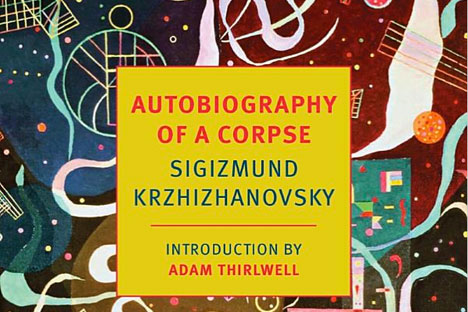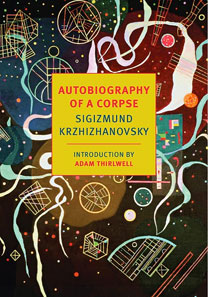
 |
| 'Autobiography of a Corpse' by Sigizmund Krzhizhanovsky, NYRB Classics, December 2013. Source: amazon.com |
Perhaps it takes a character in a Russian story to create a suicide plan that is somehow both exquisitely nihilistic and oddly, touchingly, life-affirming.
In the brutally perfect “Autobiography of a Corpse,” the Soviet writer Sigizmund Krzhizhanovsky managed to evoke the utter depths of non-existence a person can feel (or not feel), even while still breathing. In the next instant, the author celebrates the hunger to live—though not without irony.
In the title story of this magnificent collection (NYRB Classics, December 2013) an apartment dweller in Moscow kills himself. What’s special about his despair? Before he commits suicide, the protagonist makes sure the next tenant will find his diary, which he writes in the form of a letter, and it begins rather profoundly:
“Whoever you, the person in room 24, may be, the manuscript began, you are the only person I shall ever manage to make happy: you see, had I not vacated my hundred sq. feet by hanging myself from a hook in the corner by the door, you would hardly have managed to find yourself a resting place so easily.... We are not acquainted and it’s too late for us ever to be so, but that in no way prevents my knowing you….”
And thus a tortured and weirdly redemptive story unfolds.
In your eyes, the light, the heat
“In A Pupil,” is an eerily amusing story where a kind of magic realism goes awry. A young man gazes into his lover’s eyes, and in her pupil, he sees a miniature man gesturing toward him. Every time they embrace and resume some kind of intimacy, he is distracted, even obsessed with the man in her pupil. When he is finally thrust into his lover’s eye, he lives there in a state of torpor with her other past lovers.
The reader can visualize this purgatory as magically as a Magritte painting. Adam Thirlwell, the British novelist who wrote the introduction to this collection, sees him as sharing the sensibility of the fantastic, an early, and dark, Soviet Italo Calvino.
The main character ponders – living inside her eye the way Calvino’s Baron lives among the trees – the concepts of lust, love, loss, and the death of love.
In “The Runaway Fingers,” a pianist’s hand with a diamond pinky ring takes a run for it in the middle of a brilliant arpeggio, immediately bringing to mind Hans Christian Anderson’s “The Red Shoes” and the macabre humor of Gogol’s “The Nose.”
The story brings an amused satisfaction in the reader that only a subversive parable can offer.
“The manicured fingers of the famous pianist Heinrich Dorn, accustomed to strolling the ivory keys of concert pianos, were unused to perambulating wet and dirty pavements. Finding themselves on the square’s cold and sticky asphalt, picking their way through spittle and puddles of slush, the fingers now realized the folly and extravagance of their escapade. But too late.”
Later in the story, a music critic sees an ad in the newspaper: “Found: Five Fingers of a Right Hand.”
“The Runaway Fingers” was written in 1922. Krzhizhanovsky was born in Kiev in 1887; he spoke Polish growing up and traveled throughout Europe before moving to Moscow and becoming a lifelong Muscovite.
Adam Thirlwell discusses the existential erasure of the author’s life in his introduction. “Krzhizhanovsky’s life, it might have seemed, would be one more element in history’s sequence of deletions,” Thirlwell writes. “In 1957—the same year as Boris Pasternak’s “Doctor Zhivago”–a commission was set up to examine Krzhizhanovsky’s literary legacy. It lasted two years and was then disbanded, having drafted a publishing plan that was never implemented.”
In 1976, Vadim Perelmuter brought this archive of fiction to light, a treasure trove that had been sitting under brocade in the trunk of Krzhizhanovsky’s lifelong companion, Anna Bovshek.
Thirlwell describes this singularly profound work not as the gap between fiction and reality, but a metafiction that finds the gaps in “the real” itself.
“In this way, he maps one of the strangest and yet most logical topographies in literature,” according to Thirlwell: “I am neither ‘here’ nor ‘there’ but in between—in a seam.” In the story called “Seams,” Krzhizhanovsky writes: “Though I walk, look and listen beside others settled in this city, I know: They are in Moscow and I am in minus-Moscow. I am permitted only the shadows of things.”
All rights reserved by Rossiyskaya Gazeta.
Subscribe
to our newsletter!
Get the week's best stories straight to your inbox